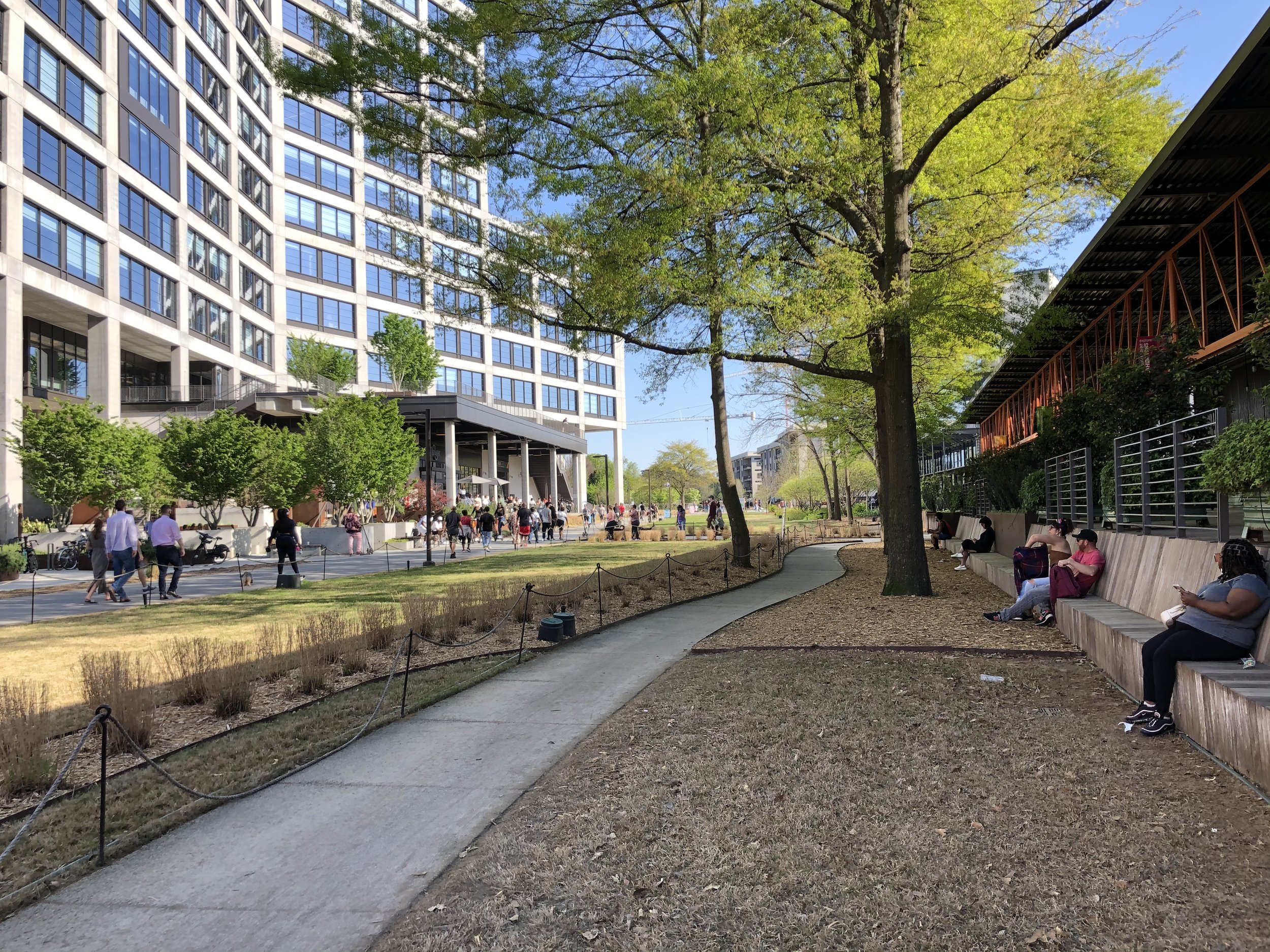Five Problems, One Solution: Why Beltline Rail Is Atlanta’s Best Investment
— Guest column by William Ezell
Eastside Trail near Ponce City Market showing transit right of way ca. 2023. Building rail where we already planned, where we are shovel-ready, and where we have the money set aside for construction is the best first step. Image: Beltline Rail Now 2023, all rights reserved
As a lifelong resident of Atlanta, I have a deep love for the city — but also a recognition of where it falls short. I want Atlanta to be the best version of itself for all of its residents, and I believe Beltline rail is crucial to that future, but before discussing the solution, it’s important to understand the challenges we face.
First, there's Atlanta's affordability crisis. According to a 2022 report from Zillow, Atlanta has a housing shortage of about 66,000 units. This issue is even more pronounced in walkable, mixed-use areas, where demand is growing among both young adults and baby boomers. As a result of this supply shortage, housing prices have increased by over 60% citywide since 2017.
Second, traffic continues to be a major problem. With 95% of Atlanta residents owning a car, traffic has become a chokehold on the city with the average Atlantan losing 65 hours annually to congestion.
Third, inequality has only gotten worse. Atlanta recently ranked 50th out of 50 large cities in a recent Harvard study for economic mobility. That’s unacceptable for a city that prides itself on opportunity and inclusion.
Fourth, Atlanta is going to continue to grow. The metro area is expected to add 1.8 million people, while the city itself is expected to double in size by 2050. Atlanta needs to be prepared for the influx of residents, or problems will only become worse.
More than 20 cities worldwide have circle lines connecting their radial transit lines. They include cities large and small, old and new. The Beltline would do for Atlanta what circular transit has done for these cities. Image: Beltline Rail Now 2022, all rights reserved
Fifth, the impacts of climate change. As sea levels rise and weather extremes intensify, Atlanta is expected to receive more than 300,000 climate migrants. At the same time, we’re facing our own climate risks—rising temperatures and extreme weather events. In just the past six months, we've experienced hurricanes, snowstorms, and droughts. To address these problems, we will need to build a livable city that doesn't just meet the needs of our current residents, but our future ones as well.
I often hear people say “Atlanta is full,” but that couldn't be further from the truth. Our population density is just 1,425 people per square kilometer—fourth lowest among the 25 largest U.S. cities. The problem isn't population, it's land use. Since the beginning of suburban sprawl in the ‘60s and the ‘70s, Atlanta has built itself around the automobile. The result has been an increased distance between places, worsened traffic, and driving as a requirement for daily life. This car-oriented development strategy has led to the Atlanta we live in today, and it is at the root of all five of the problems I’ve outlined. Solving these problems requires a fundamental change in how we develop — and public transportation is the key.
Before the dominance of the car, Atlanta developed around its streetcar network. Some of Atlanta's most beloved neighborhoods were built along streetcar lines, including Virginia-Highland, Inman Park, Candler Park, and Decatur. In these neighborhoods, you can see a mix of commercial, multi-family, and single-family housing that supports strong local communities and allows residents to meet daily needs within their neighborhoods. Their density and walkability were made possible by transit. Transit creates livable places because they are designed for people, not cars.
Atlanta Streetcar Map 1946. Source: wikimedia.org
You can see this dynamic today in Midtown. Without transit, Midtown would be impossible. Every day, 17,000 people use the area’s three MARTA stations. Imagine 17,000 more cars on Peachtree Street or the acres of parking required to store them—that's the equivalent of nine lanes of traffic and 107 acres of parking. Transit supports higher capacity without requiring more space—something no car-based solution can offer.
The demand for these mixed-use neighborhoods far exceeds the limited supply we have. In order to create these transit-oriented communities, we need transit! A recent study by MIT concluded that public transport network expansion can be an effective policy instrument to support transit-oriented urban development (TOD), increasing housing supply elasticity and improving housing affordability.
Transit is also an equitable solution. In Atlanta, many jobs, schools, health services, and other opportunities are only accessible by car. This creates a barrier to opportunity as car ownership is expensive, with an average annual cost of $12,297. This leads to economic isolation for those who can't afford a car and those who aren't old enough or able to drive. For those who do drive, it’s a serious financial burden. Cars also have hidden costs. Developers must provide parking, which takes up land that could’ve been used for something productive, or expensive parking garages, which can cost $25-70k per space. Those costs get passed on to tenants, customers, and homeowners — regardless of whether they drive.
Then there’s the climate cost. Electric trains produce 6x fewer emissions per mile than gas cars. Transit also reduces the amount of miles traveled by fostering mixed-use developments where trips are shorter and can be accomplished using active modes such as walking or biking. Public transit does more than move people from point A to point B, it helps create places that are more livable, equitable, affordable, and climate-friendly. Let's be a developed city.
“A developed country is not a place where the poor have cars. It’s where the rich use public transportation.”
Atlanta needs public transit to address its challenges, but what is the best use of our public dollars? MARTA plays an essential role in bringing people into the city, but Atlanta lacks a system that helps people move around the city. That’s where Beltline rail comes in. Beltline rail is a 22-mile light rail loop that circles the city, connecting 45 neighborhoods and linking with heavy rail, Amtrak, BRT, and bus networks. Loop lines like this are essential to world-class transit systems. They improve network connectivity, boost ridership, and dramatically increase the number of possible trips. Tokyo has the Yamanote Line. Berlin has the Ringbahn. London has the Circle Line.
A successful transit line needs both destinations and origins. There are two schools of thought on transit projects: build where the people are and where the infrastructure is at its limit, or build where the people will be. The former is more expensive because construction in dense areas is difficult. The latter is cheaper, but requires time and coordination to build TOD around the stations. Beltline rail says, why not both!
The Beltline serves dense and popular areas such as Ponce City Market, Krog Street, Piedmont Park, West Midtown, and Atlantic Station — places that can both support and benefit from rail. It also passes through underdeveloped areas like Murphy Crossing that have enormous potential for TOD. Best of all, most of the right of way is already preserved, grade-separated, and ready for tracks, and on top of that, 62% has already been acquired.
What about the cost, you ask? To you, I say there is no other transit project with the same value as Beltline rail. When proposed in 2015’s Atlanta Streetcar System Plan, the 22-mile loop around the beltline was projected to cost $1,044,000,000. Adjusting for inflation (about 37% since then), today’s cost would be $1.4 billion. If built over 15 years with 2% annual inflation, the final cost would be about $1.81 billion — or roughly $92.5 million per mile. Even with the Better Atlanta Transit estimate of $125 million per mile, Beltline rail remains valuable.
By comparison, the 6.5-mile Clifton Corridor BRT is projected to cost $1–1.3 billion. Beltline rail offers far more value per dollar.
And here’s the key: we’ve already voted for it. Beltline rail was included in the 2016 More MARTA referendum, so let’s get it built! Every year we wait, inflation drives up the cost. Atlanta needed improved transportation years ago. I'm 21 years old and I’ve never seen a MARTA extension in my lifetime. If we want a future that addresses our city's challenges and improves the lives of those of us who call Atlanta home, we need to build Beltline rail now.
William Ezell is a junior at the Georgia Institute of Technology studying industrial engineering and sustainable cities. A native of Inman Park and now living in Midtown, he’s long been passionate about how cities move and connect people. William serves as a manager for the Georgia Tech basketball team and works guest services at Mercedes-Benz Stadium, where he enjoys being part of the city’s energy. He hopes to pursue a career as a transportation planner or data analyst, helping cities become more livable and connected.




